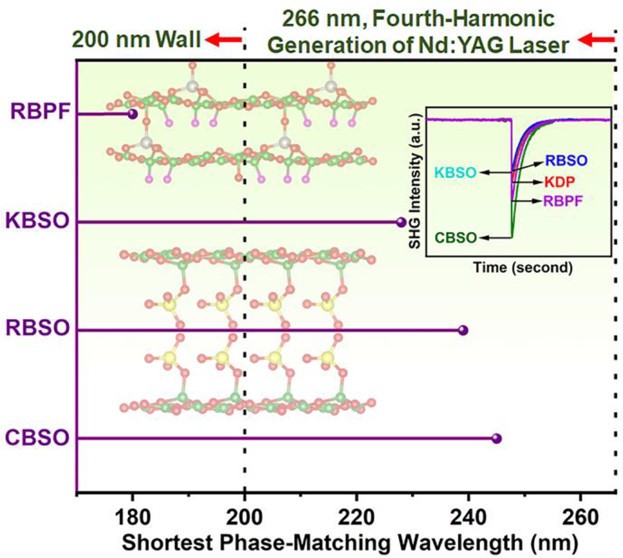Researchers synthesize short-wavelength phase-matching nonlinear optical crystals by employing KBe2BO3F2 as the template
Editor: | Dec 10,2022
Exploration of nonlinear optical (NLO) crystals that are competent in generating short-wavelength ultraviolet (UV, λ ≤ 266 nm, and even deep-UV, λ ≤ 200 nm) coherent light output by direct second harmonic generation (SHG) remains a formidable challenge.
Recently, researchers of Research Center for Crystal Materials successfully synthesized four UV/deep-UV NLO crystals, M2B4SO10 (M = K, Rb, and Cs) and Rb3B11PO19F3 by evolving the KBe2BO3F2 (KBBF) structure into mixed-anionic borosulfate and fluoroborophosphate systems. They display functional [B4SO10]∞ or [B11PO19F3]∞ KBBF-type layers that are composed of [BO3], [BO4], and [SO4] groups or [BO3], [BO4], [BO3F], and [PO4] groups, respectively. Experimental characterization and numerical computation results indicate that these crystals possess exceptional NLO performance, including large SHG responses (0.9–1.7 × KDP at 1064 nm and 0.1–0.3 × β-BBO at 532 nm) and adequate birefringence to fulfill the SHG phase-matching (PM) condition at 266 nm. In particular, the shortest type-I PM wavelength (λPM) of Rb3B11PO19F3 reaches 180 nm, which implies that Rb3B11PO19F3 can become a prospective deep-UV NLO crystal. In addition, single crystals of K2B4SO10, Rb2B4SO10, and Cs2B4SO10 are easily obtained by the high-temperature solution approach. This work will facilitate the discovery of short-wavelength PM NLO crystals by using the KBBF structure as the template.
This work was published in ACS Central Science as a Research Article (ACS Cent. Sci. 2022, 8, 11, 1557–1564).
This work was supported by This work was supported by the National Natural Science Foundation of China (61875229, 61922084, 51972336, and 61835014), the West Light Foundation of CAS (2019-YDYLTD-002), the Instrument Developing Project of CAS (GJJSTD20200007), the International Partnership Program of CAS (1A1365KYSB20200008), and the Xinjiang Major Science and Technology Project (2021A01001). The authors gratefully acknowledge the reviewers for their valuable comments and suggestions, which are beneficial to improving the manuscript.
Article:https://doi.org/10.1021/acscentsci.2c00832

附件下载:
 (86) 991-3838931
(86) 991-3838931 lhskj@ms.xjb.ac.cn
lhskj@ms.xjb.ac.cn (86)991-3838957
(86)991-3838957 40-1 Beijing Road
Urumqi, XinjiangChina
40-1 Beijing Road
Urumqi, XinjiangChina